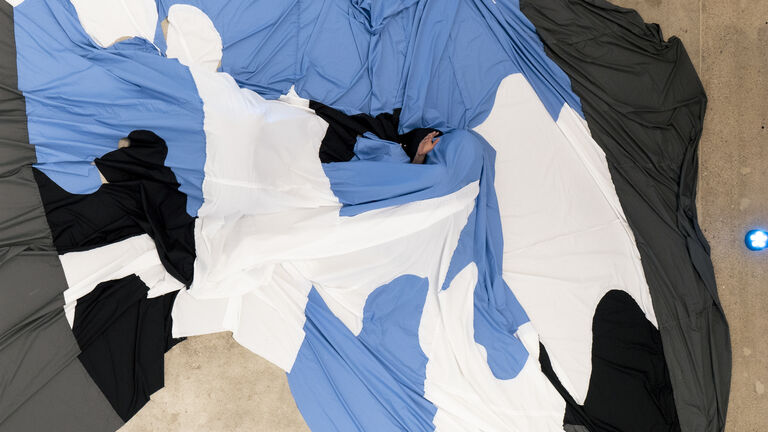
Andy Giovale BFA 23 Title: Sandtimer Photo Credit: Ruby Que
Undergraduate Overview
Undergraduate Overview
Spring 2026 Application Deadline: January 1
Fall 2026 Application Deadline: January 1
The School of the Art Institute of Chicago's (SAIC) Performance department is one of the only undergraduate contemporary performance departments in the country. We are known nationally and internationally as a center for engagement, research, and experimentation of body-focused performance art practice in an art-and-design school context.
We put a strong emphasis on contemporary art with practices and theories including:
- Live actions
- Interactive digital technologies
- Movement research
- Tactical and site performance
- Performance installation
- Abandoned practices
- Re-enactment/Reperformance
- Archiving the document
- Performance writing
The Performance program's distinguished and professionally active faculty represent a broad range of experimental performance approaches ranging from solo performance and material actions to activist participatory theater, gender performance, experimental movement performance, performance lectures, re-enactment, networked virtual performance/mixed reality, and curating.
Possible Performance Paths
Undergraduate students concentrating their BFA in Performance are encouraged to consider their art-making process as a interdisciplinary practice that can range across various departments including, but not limited to, Fiber and Material Studies; Sculpture; Performance; Fashion Design; Art and Technology / Sound Practices; Film, Video, New Media, and Animation; and Ceramics. Students are encouraged to confer with faculty to map a course of interdisciplinary study that reflects the latest developments in contemporary practices in these fields.
Below are some pathway suggestions to consider:
- Body/Performance: Intro to Performance; The Performing Body; Performing Next Feminisms; Movement Research/Improvisation; Bodies in Motion; Durations: Long, Medium, Short; and Movement/Presence: Body as Site
- Object Performance: Material Actions, Puppetry, and Performance and Event Production
- Media Performance: Performance Media; Mixed Reality Performance; Performance and Video; Live Presence/Virtual Spaces; Performing for the Camera; and Fusions: Film, Video, Performance
- Installation/Site-specific Performance: Site Practice; Tactical Performance; Event Production; and Performance Installation
- Collaborative Performance: Systems, structures: Methods of creation; Make it Strange; Collaboration/Directing for Performance; Group Work; and Between Theatre and Performance.
- Critical/Activist Social and Political Performance: Extreme bodies in Performance; Border Crossing; Performing Next Feminisms; and Tactical Performance
- Performance Writing: Body/Text; Performative Writing; Scripting/Acting for Performance; and Narrative in Performance
- Re-enactment/Reperformance: Parasitic Practices; Performing the Document; Performing Fictions; and Performance Documentation
Undergraduate Admissions Requirements & Curriculum Overview
-
To apply to the School of the Art Institute of Chicago (SAIC), you will need to fill out an application and submit your transcripts, artist's statement, and letters of recommendation. And most importantly, we require a portfolio of your best and most recent work—work that will give us a sense of you, your interests, and your willingness to explore, experiment, and think beyond technical art, design, and writing skills.
In order to apply, please submit the following items:
Bachelor of Fine Arts in Studio Portfolio
Submit 10–15 pieces of your best and most recent work. We will review your portfolio and application materials for merit scholarship once you have been admitted to SAIC.
When compiling a portfolio, you may concentrate your work in a single discipline or show work in a breadth of media. The portfolio may include drawings, prints, photographs, paintings, film, video, audio recordings, sculpture, ceramics, fashion designs, graphic design, furniture, objects, architectural designs, websites, video games, sketchbooks, scripts, storyboards, screenplays, zines, or any combination of the above.
Learn more about applying to SAIC's Bachelor of Fine Arts in Studio, or view our portfolio preparation guide for more information.
-
Studio 69 - CP 1010 Core Studio Practice I (3)
- CP 1011 Core Studio Practice II (3)
- CP 1020 Research Studio I (3)
- CP 1022 Research Studio II (3)
- SOPHSEM 2900 (3)
- PROFPRAC 39XX (3)
- CAPSTONE 49XX (3)
- Studio Electives (48)
Art History 15 - ARTHI 1001 World Cultures/Civilizations: Pre-History—19th Century Art and Architecture (3)
- Additional Art History Course at 1000-level (e.g., ARTHI 1002) (3)
- Art History Electives at 2000-, 3000-, or 4000-level (9)
Liberal Arts 30 - ENGLISH 1001 First Year Seminar I (3)
- ENGLISH 1005 First Year Seminar II (3)
- Natural Science (6)
- Social Science (6)
- Humanities (6)
- Liberal Arts Electives (6)
- Any of the above Liberal Arts or certain AAP or EIS
General Electives 6 - Studio, Art History, Liberal Arts, AAP, or EIS
Total Credit Hours 120 * BFA students must complete at least two classes designated as "off campus study." These classes can also fulfill any of the requirements listed above and be from any of the divisions (Art History, Studio, Liberal Arts, or General Electives).
BFA in Studio with Thesis Option (Liberal Arts or Visual Critical Studies): Students interested in pursuing the BFA in Studio with the Thesis Option (Liberal Arts or Visual Critical Studies) should contact their academic advisor for details about eligibility, program requirements, and the application process.
Total credits required for minimum residency 66 Minimum Studio credit 42
Course Listing
Upcoming Admissions Events
Meet with us, learn more about SAIC and our curriculum, and get feedback on your work. LEARN MORE.
Get More Info
Sign up for email updates to learn more about our undergraduate programs.